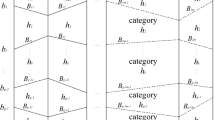Abstract
A system that aggregates case-based linguistic decision rules using a hybrid of the dominance-based rough set approach (DRSA) and the Dempster–Shafer (DS) theory of evidence is proposed for multiple criterion-multiple participant sorting. First, DRSA is employed to infer linguistic decision rules that estimate the preferences of a few participants by means of their evaluations of representative case sets. Next, DS theory is applied to aggregate the decision rules triggered by all participants’ evaluations of an alternative, thereby generating an overall decision recommendation for the alternative. The method is demonstrated on a numerical example.
Similar content being viewed by others
References
Arrow KJ (1963) Social choice and individual values, 2nd edn. Wiley, New York
Beynon M, Curry B, Morgan PH (2000) The Dempster–Shafer theory of evidence: an alternative approach to multicriteria decision modelling. OMEGA 28(1): 37–50
Beynon M (2002) DS/AHP method: a mathematical analysis, including an understanding of uncertainty. Eur J Oper Res 140(1): 149–165
Beynon M (2005) A method of aggregation in DS/AHP for group decision-making with the non-equivalent importance of individuals in the group. Comput Oper Res 32: 1881–1896
Beynon M (2006) The role of the DS/AHP in identifying inter-group alliances and majority rule within group decision making. Group Decis Negotiat 15: 21–42
Blaszczynski J, Salvatore G, Slowinski R (2007) Multi-criteria classification—a new scheme for application of dominance-based decision rules. Eur J Oper Res 181(3): 1030–1044
Bui TX (1987) Co-oP: a group decision support system for cooperative multiple criteria group decision making. Springer, Berlin
Butler AC, Sadeghi F, Rao SS, LeClair SR (1995) Computer-aided design/engineering of bearing systems using the Dempster–Shafer theory. Artif Intell Eng Des Anal Manuf 9: 1–11
Chambers R, Melkonyan T (2008) Eliciting beliefs. Theory Decis 65: 271–284
Chen Y, Kilgour DM, Hipel KW (2007) Multiple criteria sorting using case-based distance models with an application in water resources management. IEEE Trans Syst Man Cybern Part A 37(5): 680–691
Chen Y, Kilgour DM, Hipel KW (2008a) A case-based distance model for multiple criteria ABC analysis. Comput Oper Res 35(3): 776–796
Chen Y, Kilgour DM, Hipel KW (2008b) Screening in multiple criteria decision analysis. Decis Support Syst 45(2): 278–290
DeKorvin A, Shipley MF (1993) A Dempster–Shafer-based approach to compromise decision making with multiattributes applied to product selection. IEEE Trans Eng Manag 40(1): 60–67
Dempster AP (1968) A generalization of Bayesian inference. J Roy Stat Soc Ser B 30: 205–247
Doumpos M, Zopounidis C (2002) Multicriteria decision aid classification methods. Kluwer, Dordrecht
Fang L, Hipel KW, Kilgour DM (1993) Interactive decision making: the graph model for conflict resolution. Wiley, New York
Fraser NM, Hipel KW (1984) Conflict analysis: models and resolutions. North Holland, New York
Greco S, Matarazzo B, Slowinski R (2001) Rough set theory for multicriteria decision analysis. Eur J Oper Res 129: 1–47
Greco S, Matarazzo B, Slowinski R (2002) Rough approximation by dominance relations. Int J Intell Syst 17: 153–171
Howard N (1971) Paradoxes of rationality: theory of metagames and political behavior. MIT Press, Cambridge
Hurley TM, Shogren JF (2005) An experimental comparison of induced and elicited beliefs. J Risk Uncertain 30: 169–188
Hwang CL, Lin MJ (1987) Group decision making under multiple criteria. Lecture Notes in Economics and Mathematical Systems, No. 281. Springer, Berlin
Ignizio JP (1991) Introduction to expert systems: the development and implementation of rule-based expert systems. McGraw-Hill, Columbus
Institute of Computing Sceience (ICS) (2008) Poznan University of Technology, Poland, 4eMka2 software. http://idss.cs.put.poznan.pl/site/4emka.html. Accessed on 18 Feb 2008
Jacquet-Lagrèze E, Siskos Y (1982) Assessing a set of additive utility functions for multicriteria decision-making: the UTA method. Eur J Oper Res 10: 151–164
Keeney RL, Raiffa H (1976) Decision with multiple objectives: preferences and value tradeoffs. Wiley, New York
Mousseau V, Slowinski R (1998) Inferring an ELECTRE TRI model from assignment examples. J Glob Optim 12(2): 157–174
Myerson RB (1997) Game theory: analysis of conflict. Harvard Univerity Press, Cambridge
Pawlak Z (1982) Rough sets. Int J Comput Inf Sci 11: 341–356
Pawlak Z, Skowron A (2007) Rudiments of rough sets. Inf Sci 177: 3–27
Raiffa H, Richardson J, Metcalfe D (2002) Negotiation analysis: the science and art of collaborative decision making. Harvard University Press, Cambridge, USA
Roy B (1996) Multicriteria methodology for decision aiding. Kluwer, Dordrecht
Saaty TL (1980) Analytic hierarchy process. McGraw Hill, New York
Shafer G (1976) A mathematical theory of evidence. Princeton University Press, Princeton
Silver EA, Pyke DF, Peterson R (1998) Inventory management and production planning and scheduling, 3rd edn. Wiley, New York
Wallenius J, Dyer JS, Fishburn PC, Steuer RE, Zionts S, Deb K (2008) Multiple criteria decision making, multiattribute utility theory: recent accomplishments and what lies ahead. Manag Sci 54(7): 1336–1349
Yager RR, Kacprzyk J, Fedrizzi M (1994) Advances in the Dempster–Shafer theory of evidence. Wiley, New York
Yang JB, Singh MG (1994) An evidential reasoning approach for multiple-attribute decision making with uncertainty. IEEE Trans Syst Man Cybern 24(1): 1–18
Zopounidis C, Doumpos M (2002) Multicriteria classification and sorting methods: a literature review. Eur J Oper Res 138: 229–246
Author information
Authors and Affiliations
Corresponding author
Rights and permissions
About this article
Cite this article
Chen, Y., Kilgour, D.M. & Hipel, K.W. A Decision Rule Aggregation Approach to Multiple Criteria-Multiple Participant Sorting. Group Decis Negot 21, 727–745 (2012). https://doi.org/10.1007/s10726-011-9246-6
Published:
Issue Date:
DOI: https://doi.org/10.1007/s10726-011-9246-6




